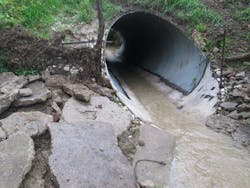Culvert Repair: Culvert Complications
Elba Township in Knox County, Ill., faced a potentially severe infrastructure problem when its roads program detected a 9-ft-diameter corrugated metal pipe (CMP) that was rusting through the invert of the pipe.
At some points, water was beginning to undermine the integrity of the culvert, forcing the township to take action or risk affecting the roadway embankment. If not addressed quickly, problems like these have the ability to grow exponentially in short period of time, especially with the freeze-thaw experienced in the Midwest. Any further deterioration of the slope could have forced an unscheduled, expensive and time-consuming replacement of the culvert, so immediate action was needed. Additionally, as a result of the soils and/or fertilizers used in this agricultural area, storm water runoff magnified the corrosion rate of the metal culvert. Early signals of significant erosion at the inlet and outlet of the culvert needed to be mitigated, and thus, a culvert repair was needed.
Complicating some of these issues was the challenge of accessing the pipe itself. The meander of the water at the inlet combined with fencing in the area made accessing that end of the pipe extremely difficult. In addition, nature had created a stilling basin at the outlet of the pipe.
The Solution to Repairing the Culvert
One possible solution was to pour concrete in the invert in order to reestablish the bottom of the pipe. A number of liners, as well as complete replacement, were evaluated but ultimately ruled out due to the limited budget available. Positioning the appropriate equipment near the culvert alone would have been a complicated and time-consuming process.
Milliken Infrastructure Solutions’ Concrete Cloth geosynthetic cementitious composite mat (GCCM) was selected to address all the challenges in a single solution. GCCMs are form fitting, yet flexible concrete impregnated fabrics that harden on hydration to form a durable, protective concrete layer. The GCCM repair was set in motion when the county road commissioner and the county engineer agreed to share the repair expenses with the township using joint bridge funds. The idea was to extend the life of the culvert until funds were available in the future.
On day one of the repair, access to the site was cleared and a load of riprap was staged close to the culvert ends so that it could be placed after the GCCM was installed. The following day, the GCCM was placed and powder-actuated fasteners were used to affix the material to the culvert. The Concrete Cloth GCCM was then hydrated so that it would harden in place. The installation took just 2.5 hours to complete.
On the final day of the installation, mastic was placed along the high edge of the GCCM, preventing water from getting between the material and the metal culvert. The contracting team indicated it would expect to install the material in similar applications throughout the area, as it was impressed with Concrete Cloth GCCMs’ ability to speed up the installation process and be modified with simple box cutters.
The Results of the Culvert Repair
The road commissioner and others associated with the project were very pleased with the look of the culvert repair solution, impressed by the flexibility of the Concrete Cloth as part of a system solution that included riprap and eager to see it perform under the region’s harsh winter conditions.


